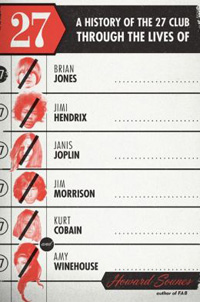“You’re drinking with number three,” Jim Morrison allegedly declared, equal parts sardonic and prescient, following the successive deaths of Janis Joplin and Jimi Hendrix in 1970. As it happened, he was correct. In less than a year these superstars were gone, all at the age of 27.
For his new book, 27, Howard Sounes researched the number of musicians who’ve actually died at 27 and discovered the total was 50. But the list of famous, or infamous cases comprising the so-called “27 Club” is much shorter, six to be exact. They are, in chronological order, Brian Jones, Janis Joplin, Jimi Hendrix, Jim Morrison, Kurt Cobain and Amy Winehouse.
What ties these six artists together, aside from their obvious ages and occupations, is the fact that some measure of controversy dogs each death, and Sounes sets out to examine the various coincidences and conflicting stories, seeing what they all add up to.
Conclusion: not much. Despite the considerable talent, promise and tragedy we can attribute to each of these artists, they all serve as cautionary tales of excess, poor judgment and wasted potential. In the cases of Morrison and Hendrix, enough material was recorded to ensure a definitive legacy; with Cobain and Winehouse we are left wondering how many years, even decades, of genius they forfeited.
In the cases of Jones and, to a lesser extent Joplin, they seemed hell-bent on self-destruction, and might well have viewed death as a refuge of sorts. And while Joplin arguably did her best work at the end, Jones had ceased to contribute much of anything, and was a bloated, neurotic mess long before his ill-advised midnight swim.
Sounes constructs mini-biographies of each musician, making Winehouse, who receives quite a bit more attention and time, the centerpiece. The author admits that he has more personal interest in Winehouse, particularly as a fellow Londoner, and it was presumably much easier to find family and friends to speak with. For the four who died between 1969 and 1971, he relies on myriad sources, and his bibliography is impressive, if intimidating. Make no mistake, Sounes did heavy lifting to make this book as authoritative as possible.
If you are already familiar with these musicians, there are not a ton of new or especially interesting insights to be found. On the other hand, if you want exhaustive, at times exhausting detail regarding their collective debauchery, 27 may have that kind of perverse train wreck appeal.
Interestingly, or not, while Winehouse gets more than twice as much ink as the others, much of it is spent in the service of depressingly redundant recollections of her binges and outbursts. Not unlike with Joplin, Jones and Morrison, one comes away wondering not why they died so young, but how they managed to live as long as they did.
Indeed, Sounes betrays a soft spot for Winehouse, at times acting like a priest or psychiatrist, where he is mostly content to dismiss Morrison and Jones as burned out buffoons. In the latter’s case, there weren’t too many people willing to say many nice things: Jones comes off as a petulant, abusive bully, a man-child who might have ended up in jail or in a ditch if not for his musical skills and fortuitous association with Mick Jagger and Keith Richards.
Morrison, on the other hand, warrants more nuance and empathy than Sounes is capable of conjuring. True, the Lizard King was, by most accounts, all too often a braying, inebriated ass. On the other hand, there are plenty of friends and acquaintances who describe him as the proverbial Jekyll and Hyde: when not drunk, he was capable of humor, kindness and generosity. And he was also capable of ethereal brilliance; lost on Sounes are the ways Morrison channeled his vices into unique and affecting visions. A simple assessment of his material dealing with alcohol reveals a trifecta of masterful songs that also work as poetry: “Roadhouse Blues”, “End of the Night” and especially what might rank as rock music’s finest meditation on the irresistible pull of drink, “The Crystal Ship”.
Like Hendrix, Joplin simply seemed to get caught up in the chaos that accompanies life in the spotlight; unlike Hendrix, she had deep-rooted insecurities and a profound self-loathing (like Cobain and Winehouse) that led her to seek solace from miscellaneous chemicals. Hendrix is the only one who seems relatively well-adjusted and mostly in control of his faculties throughout. He enjoyed the party because he could, but he took his life, and his music, very seriously. More, he harbored no apparent desire to harm or annihilate himself, so his death still seems a genuine misadventure, a freak incident that still stings to this day.
Sounes helpfully demolishes any/all conspiracy theories, ranging from the familiar (Morrison lives!) to the far-fetched (Hendrix was murdered), and while we’ll never know exactly what happened to Jones and Joplin, the drugs found in their systems combined with the backstory of their final months in this earthly form leave little to the imagination.
27 also serves as a corrective of sorts for the half-assed mythologizing, particularly of Morrison and Cobain, both of whom have, for a variety of understandable if facile reasons, been posthumously anointed as voices of their generation. Both Cobain and Morrison had upbringings that left them ill-prepared for adulthood, much less celebrity. But there was no shortage of self-indulgence as well, and while anyone with a heart can feel genuine empathy, the record leaves no question these men were surrounded by concerned support systems, and wealth, that might have made a difference.
In a fascinating twist, just about all the maligned parents obtain an odd, non-rock and roll vindication, courtesy of their offspring. In the cases of Joplin, Hendrix and Morrison, all were estranged from their parents, all of whom ended up wealthy beneficiaries of careers they never approved of, but perhaps unintentionally did much to inspire.

